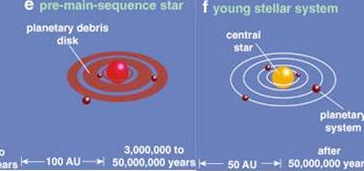The stars we see in the night sky are not eternal. In fact, new stars are constantly being born while old ones are dying. Our own star - the Sun - was born about 4.5 billion years ago along with the planets around it, including the Earth. So, in a way, if we want to understand how we got here, we need to figure out how stars and planets form in the Galaxy as a whole. In a nutshell, the process is governed by an imbalance between pressure and gravity. The gas and dust in the Interstellar medium has an internal pressure which is related to its
temperature and density. At some point, a small piece of a larger interstellar cloud (let’s call this a “core”) can become condensed to the point where its mass (and hence gravity) is large enough to overcome its internal pressure (figure a). At this stage, pressure can no longer support the “weight” of the core and it begins to collapse under the force of gravity - becoming smaller, denser and hotter (figure b). This is referred to as the “protostellar” stage in which the young, fetal protostar is still deeply embedded in, and enshrouded by, its natal envelope.
Of course, these cores are not stationary. They are constantly moving and often slowly spinning. As they collapse, however, they begin to spin faster - much like a figure skater spins faster as he pulls his
arm in. As the core spins faster and faster while it collapses, the envelope surrounding the protostar begins to flatten like pizza dough (figure e). Thus, a flattened disk begins to form around the protostar. It is within this disk that planets will coalesce and form (figure f).
Ultimately, the gas in the core becomes so hot (greater than 10,000,000 degrees) that the hydrogen atoms begin to fuse - producing a stable source of energy. At this stage, a star is born!
There are a number of problems associated with actually observing the process of star formation, however, not the least of which is the fact that forming stars and planets takes a very long time (millions to billions of years) and so we can’t pick out a particular region in space and watch it go through all the steps on its way to becoming a star. Instead, we rely on statistics. Imagine an alien took a picture of a busy city street like the one on the left. In that one pictu
re, it would see babies, toddlers, teenagers, and young and old adults. From that one snapshot, the alien could deduce a fairly accurate picture of how humans evolve - from birth to death. We do the same in astronomy. The picture at the top of the Home page shows a region of active star formation which contains many stars in different stages of its evolution. By studying each of these objects we begin to understand the long and complicated process of stellar birth and evolution.
Another problem is the fact that the initial stages of human development (i.e. the fetus) is not directly observable. The earliest phases of stellar birth have a similar problem - they are deeply embedded within, and enshrouded by, the natal clouds of gas and dust in which they are conceived. Fortunately, in the same way that we have developed techniques to “see” the fetus inside the mother, astronomers have developed different techniques to “see” the fetal star (called a protostar) within the cold, dense cloud from which they form. This technique involves using infrared and radio radiation emitted by the protostar and the surrounding gas and dust from which it forms.





